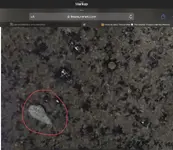Hi
@Chr038
I declined to comment on your initial post simply because sometimes there’s not much that can be helpfully said from the information and pictures provided… except that, in this case, there are some characteristics that
could be attributed to a meteorite and some “little round balls” that have at least the superficial appearance of chondrules.
Now that you have provided the additional analytical information, I can perhaps comment a little more helpfully.
You say that “
every geologist or meteoricist online says there's a flaw in the report” (on the first page). Who exactly were these commenters (with what degree of experience in meteoritics) and surely they would have said what they believe the “flaw” to be?
I would say the following. The first page of the report (the second of your pictures) has a section titled “Key Diagnostic Indicators” and reports a Fe value of 6.786% with a Mn value of 0.091%. I’m guessing that’s what is being flagged as the “flaw” in the report.
Fe/Mn ratios are often touted as a key diagnostic for meteorites and, in this case, 6.768/0.091 gives a ratio of 74. That’s low for a chondritic meteorite (one would normally expect it to be >100). However, although the ratio doesn’t vary much within different groups of meteorites and some achondrite types have low values (euchrites are habitually lower than 50 for example), it’s not as “diagnostic” as some reference sources would suggest. There are some chondrite types which are lower than 100 and could conceivably be as low as 74, but those would be far less usual versus the possibilities for terrestrial materials (and also many Earth rocks have values in the range of meteoritic possibilities).
In defence of the analytical conclusions in the report I would say that although the Fe/Mn ratio
on its own is not a key diagnostic, it becomes so if considered
in conjunction with the other results and observations. So, not so much a “flaw” in the report, but more a general observation that hasn’t been portrayed in its proper context. That is, a chondrite couldn’t have a value that low while also having the other reported compositional values.
There are multiple clues in the report which, collectively, rule out this being a meteorite. For example, the silicon content is reported as 21.01%, so this would have to be a stony meteorite (If it were a meteorite). One of the best analytical parameters for distinguishing stony meteorites from Earth rocks is chromium content, since such meteorites almost invariably have high concentrations of chromium versus terrestrial rocks. The reported value is 376 ppm, whereas I would expect a value in excess of 1,000 ppm for a meteorite.
The report also says “
optical analysis shows quartz”. That’s very much a “diagnostic” but it’s a
contra-indicator for meteorites. Quartz is not found in meteorites with the exception of a few rare carbonaceous chondrites, which this specimen could not be. Even in those carbonaceous chondrites, the quartz crystals are microscopic in size and extremely low in abundance.
I don’t see any reason to doubt the laboratory’s conclusion that this is terrestrial material. Hope that helps.







 those rocks will melt at 1200° circa... a meteor undergo at over 2000° we expect a fusion ring around the cut rock...
those rocks will melt at 1200° circa... a meteor undergo at over 2000° we expect a fusion ring around the cut rock...
